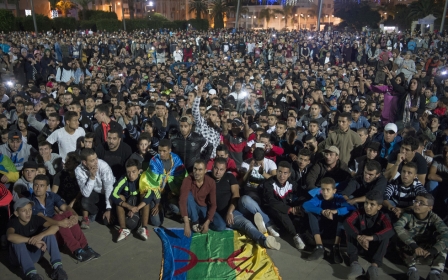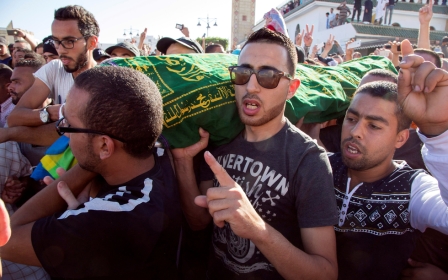Protesters gather in Hoceima to mark week since fishmonger's death
Protests took place in the Moroccan port of Hoceima on Friday evening one week after a fishmonger was crushed to death in a rubbish compactor while trying to retrieve fish confiscated by police.
Mouhcine Fikri's death, which was captured on video and widely shared via social media, prompted protests in Hoceima and several major cities in Morocco where displays of public dissent are rare.
Police had confiscated and destroyed Fikri's catch of swordfish because fishing for swordfish is banned at this time of year.
Thousands of people gathered at Mohammed V square in Hoceima on Friday evening to protest, chanting slogans against "terrorist assasin" police and "Mouhcine has been killed, Mahzen is reponsible", referring to the government.
The protest later moved from the square into the street, with demonstrators remaing in silence. It ended peacefully on Friday.
“We keep silent to pay respect to Mouhcine" said Mohammed, one of the organizer of the demonstration, speaking to Middle East Eye.
MEE spoke to Fikr's father, who said he had "nothing against demonstrations but they should remain peaceful".
Hoceima's harbour was quiet on Friday morning with fishermen saying that the ban had badly affected their livelihoods.
"Four years ago we modernised our equipment but now, with this ban, this is wasted money," said Nourredine Abassi, a 47-year-old fisherman, who told MEE how he used to catch swordfish every day.
Popular outrage over Fikri's death prompted Morocco's King Mohamed VI to send Mohamed Hassad, the country's interior minister, to meet his family.
Hassad ordered an investigation to "determine the exact circumstances of the tragedy and punish those responsible".
But the government has nonetheless faced anger in the streets and on social media, with Twitter users adopting the hashtag "Crush his mother" - a reference to what was allegedly said by police before Fikr's death - to report updates on the protests around the country.
The hashtag "we are all riffians" was also used, which referred to the Berber ethnic group from the Rif region in northern Morocco.
The Rif used to be an independent state but is now part of Morocco, and its distinctive red flag was seen in protests and on social media.
The Amazigh flag, which represents Berbers more generally, was also seen in the protests.
"People from the Rif region are free, they want the Makhzen to go away. We are not arabs, we are from the Rif region," an activist told MEE next to a massive crowd with several amazigh flags.
The current protests are the largest and most sustained in Morocco since the 2011 "Arab Spring" when the king pushed through measures including political reforms, increased spending and tougher security to appease and quell unrest on the streets.
This article is available in French on Middle East Eye French edition.
New MEE newsletter: Jerusalem Dispatch
Sign up to get the latest insights and analysis on Israel-Palestine, alongside Turkey Unpacked and other MEE newsletters
Middle East Eye delivers independent and unrivalled coverage and analysis of the Middle East, North Africa and beyond. To learn more about republishing this content and the associated fees, please fill out this form. More about MEE can be found here.






